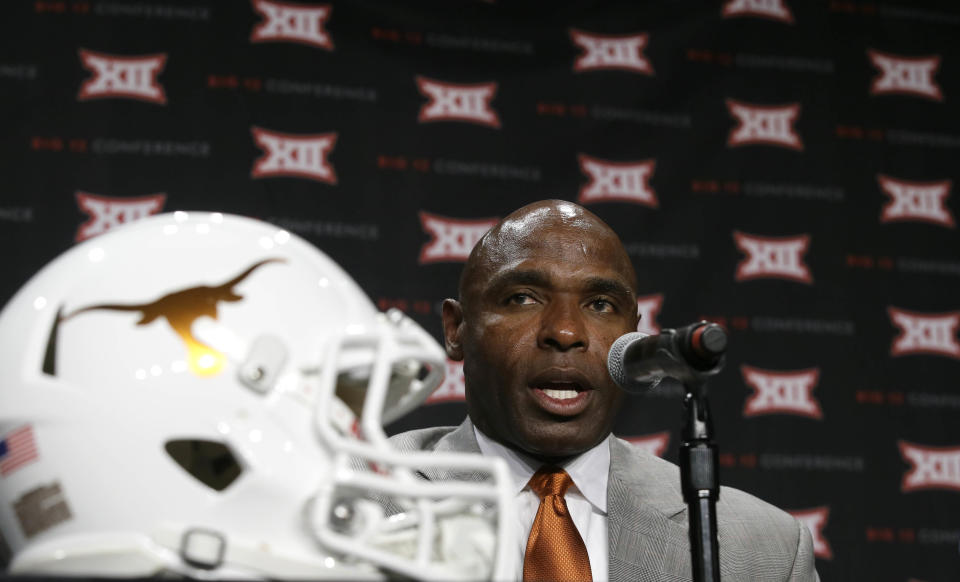Big 12's status among the Power Five clearly in jeopardy

As the Big 12’s tortured expansion process continues, a much-prophesied future is becoming increasingly likely: The Power 5 conferences could well wind up becoming the Power 4 in less than a decade.
The Monday story from Sports Business Journal on the schism between the Big 12 and its TV partners, ESPN and Fox, further reveals the weakness of the conference. An expansion gambit that would contractually add dollars to the league but also do little to improve its quality is meeting heavy resistance from the most powerful TV entities in college sports.
This is one more example of a league that has lost significant ground in the athletic arms race and is unsure what to do about it.
At its spring meetings in early June, the Big 12 was clearly predisposed against expansion. By football media days seven weeks later, a transformation had occurred – the league said it was looking seriously at expansion. That was a presidential-level decision that seemed to come as startling news to some athletic directors and coaches.
Shortly thereafter, presidents were publicly backing candidates – Texas and Texas Tech got behind Houston – and those on the outside were feverishly elbowing for a ride on what looked like the last chopper out of mid-major Saigon. From Boise State in the west to Connecticut in the east, schools on the outside launched P.R. offensives to sell themselves as Big 12-worthy.
But now, as the calendar turns to August, here come the TV suits to slow the Big 12’s roll. ESPN and Fox are sending clear signals that an expanded Big 12 won’t be viewed as a better Big 12 – at least not a Big 12 worth more media rights fees. It is another remarkable plot twist, and it shows that the conference is very vulnerable when/if the next big realignment earthquake hits college sports.
That could happen by 2024 at the latest, when the current sets of major TV rights deals expire. The jockeying will begin before that. And the Big 12 could be poached.
With the announcement last month that there will be an ACC network in conjunction with ESPN, that leaves the Big 12 as the only Power 5 league without one. Which means the long-term revenue gap will continue.
It also is the only league without at least 12 teams. That means the stability gap will continue. And adding BYU and Houston – or BYU and Houston and Cincinnati and, say, Memphis, if the would-be expansion is by four schools – isn’t much of a guarantee against future poaching.
Topping it off, the disparity between the revenue, profile and influence of Texas and Oklahoma and the rest of the conference creates a greater power imbalance than in any other league. Nobody else has as many members who are simply along for the Power 5 ride and not making vital contributions to the overall betterment of the conference.
Given all that, the Big 12’s status among the Power 5 clearly is jeopardized. Which means the long-predicted Darwinian Final Solution seems more likely than at any other time.
Four conferences of 16 teams has been talked about forever, especially during the realignment panic of 2010. It nearly happened then, with Texas strongly considering an exit from the Big 12 at a time when Texas A&M and Missouri already were leaving for the SEC, Colorado had left for the Pac-12 and Nebraska for the Big Ten. The league was salvaged, but it has not kept pace with the others – most importantly the Atlantic Coast Conference, which faced its own vulnerability but has smartly maneuvered itself onto more solid ground.

Thus it’s not overly difficult to foresee Texas and Oklahoma making a break for it for real next time, triggering the power-conference endgame. If the SEC, Big Ten, ACC and Pac-12 all kept their current members and descended upon the Big 12 like carrion, here’s one guess what it could all look like come 2024:
SEC new members: Oklahoma and Oklahoma State. The Sooners are the big prize and the tagalong Cowboys are the lottery winners by virtue of state politics and Boone Pickens.
Big Ten new members: Kansas and Connecticut. It would be a basketball-centric expansion for a conference that already has sufficient football flagships. It also would further the league’s foothold in the New York area, while simultaneously preventing UConn from being the single biggest loser of all realignment.
Pac-12 new members: Texas, BYU and two from a group of Texas Tech, Baylor, TCU and Houston. Or BYU could be the odd team out in favor of an all-Texas foursome.
ACC: Notre Dame and West Virginia. Or the Fighting Irish could continue their current relationship as a football scheduling partner and otherwise full ACC membership. The ACC could make do with 15 in football and 16 in basketball, or it could add Cincinnati to make it 16 and 17.
That arrangement would cut loose Kansas State and Iowa State, plus one or two Texas schools, from The Club. That’s the peril of being the least-attractive members of the least-stable conference in the current Power 5.
(But, really, if it comes down to the realignment to end all realignment, all Power 5 memberships could be up for grabs. The Arizona schools could suddenly decide they want to lobby for SEC inclusion. The Big Ten could follow through on its much-speculated coveting of North Carolina and Virginia. Washington State and Boston College could face eviction from the Pac-12 and ACC, respectively. Who knows.)
In a lot of ways, it would be a shame if the schools in the Big 12 footprint wander off to various corners of the country. It already happened in the northeast, with fairly significant competitive effect. Look at the football records of the northeast diaspora since they relocated in recent years:
In Four Big 12 seasons, West Virginia has an overall record of 26-25 and a conference record of 15-21. Rutgers is 12-13 in two Big Ten seasons, 4-12 in league play.
Boston College enjoyed a program bump during the Matt Ryan Era, but in the past six years in the Atlantic Coast Conference the Eagles have an overall record of 30-45 and a league mark of 16-32. That includes an 0-8 record last year.
Syracuse, which joined Pittsburgh in jilting the American Athletic Conference for the ACC in 2013, has gone 14-21 overall, 7-17 in the conference. The Orange are on their third coach in the past five seasons.
Pittsburgh has come the closest to tasting gridiron success in its new league – which isn’t saying much. The Panthers are 21-18, 13-11 in the conference, having experienced coaching addition by subtraction with the departure of Paul Chryst and arrival of Pat Narduzzi.
They’ve all found increased revenue and stability in their new homes, but decreased competitiveness. That’s the tradeoff.
But the northeast was historically a loose confederation of programs, most of them independents who coalesced around a basketball idea in the Big East. When Penn State went west in the early 1990s to join the Big Ten, that took away the potential anchor.
The Big 12’s bedrock schools were a conglomeration of Big Eight and Southwest Conference, but they also had more of a shared history and shared geography, with more history of success. And they were football-first athletic programs for the most part.
They have more of an actual identity to lose if their conference disintegrates, and only themselves to blame. And given the latest development in the Big 12’s laborious Summer of Expansion, the league is as vulnerable as ever.

 Yahoo Sports
Yahoo Sports 